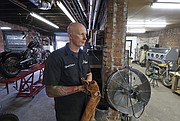2016 Vintage 1000
Speed Deluxe’s second annual Vintage 1000 is already sold out. To put your name on the wait list, or to sign up for next year’s ride, call the shop at 423-760-8475.
Speed Deluxe Grand Opening
Located at 515 Cherokee Blvd., Speed Deluxe plans to host its grand opening this month. The date is TBA. For more information visit speeddeluxe.com.
On a sunny October afternoon in Leeds, Alabama, a fleet of vintage dirt bikes idle in a pasture edged with dense forest.
"Ten seconds!" a man shouts. The riders adjust their helmets. Engines buzz like cicadas. A man in the distance whips a flag in the air and the riders are off. They rocket down a grassy knoll and disappear beyond the treeline.
Every year, tens of thousands of vintage motorcycle enthusiasts converge at the Barber Motorsports Park near Birmingham for the annual Barber Vintage Festival. The three-day race event includes road race, motocross, dirt track, trials and cross-country.
Cross-country is an off-road motorcycle race, often taking riders through dense woodlands. Most races cover 4-5 miles and last about an hour. Speeds reach only about 50 miles per hour, which may not sound fast - until one considers a front wheel crashing into an unseen log at that speed.
Entrants are divided into different classes depending on their age, type of bike, or both. Per the American Historic Racing Motorcycle Association, a vintage bike is one built before 1980. There is no advantage to racing vintage bikes versus modern, says 37-year-old Englishman Adam Sheard.
"You only do it if you love it. You're very sore afterward," he says.
Sheard has always tended toward a fast-paced lifestyle. In his early 20s he fell in love with dragsters. Fast cars led him to motorcycles. He spent his early 30s continent-hopping, moving from Europe to New Zealand to Australia. There, he met American motorcyclist and future wife Jamie Clough.
In 2013, the couple moved to the Scenic City where they opened Speed Deluxe, a motorcycle shop specializing in restoration and service of pre-1980 machines. Originally in Soddy-Daisy, Speed Deluxe recently relocated to the North Shore. The new two-story space, slated to open this month, is triple in size and function, featuring a garage, retail and even a coffee bar.
The bike garage, located downstairs, is shared with Justin Shipp's handmade-steel-bicycle company Silent Cycles. Upstairs is divided between retail and coffee bar, which will be sponsored by Velo Coffee Roasters.
Spencer Perez, Velo's director of quality and research, began riding motorcycles a year ago. He met Adam and Jamie Sheard through the couple's inaugural Vintage 1000, a five-day, 1,000-mile motorcycle ride from Tennessee to Mississippi.
The Sheards organized the event in August. To make it more accessible, they mandated that participants could not spend more than $1,000 outfitting their bikes. Seven riders registered, including Perez and Adam Sheard. Jamie Sheard managed the support vehicle - which was needed almost immediately.
Seven miles into the ride, Perez's transmission blew. Seventy miles from the finish, Adam Sheard's oil line was damaged, draining his engine of oil. Ultimately, only one rider completed the 1,000 miles. But the event served its purpose: to foster love for vintage machines and recruit new riders for racing, which Jamie Sheard calls an aging sport.
"There are some young guys that do it but there's a lot more older guys. We want to make it sustainable," she says.
In fact, three of the competitive classes offered in vintage cross-country are exclusive to riders over age 50, 60 or 70.
Perez, 25, plans to begin racing vintage cross-country once his bike is running again.
While rebuilding bikes is the Sheards' livelihood, vintage cross-country racing is Adam Sheard's passion. During last year's Barber Vintage Festival, he competed in the "Open 250 Vintage" class. The number "250" refers to the bike's "CC," which stands for cubic centimeters. In general, the higher the number, the more powerful the ride.
To gain advantage, riders often rebuild their bikes focusing on two attributes: simplicity and suspension. However, all modifications must adhere to the American Historic Racing Motorcycle Association regulations. First, motorcycles are stripped of all unnecessary weight. The lighter the bike, the easier it is to handle and the faster it goes.
"It is also less stuff that can break," says Adam Sheard, whose 1971 Triumph "Scrambler" runs off only three wires, bypassing the need for a battery or even an ignition switch.
Suspension determines a machine's sensitivity to bumps and ruts. The more inches of suspension travel, the less the rider feels those impacts.
"The suspension on a modern bike takes up an amazing amount of the ride's harshness," Adam Sheard says. Dirt bikes built after 1980 boast up to 12 inches of suspension travel whereas the first dirt bikes featured only 3-4 inches. Per regulations, a vintage bike used in cross-country racing is limited to 6-inch front suspension and 4-inch rear suspension.
As Adam Sheard explains, "Your legs become the shock absorbers. [The bike] is not soaking up any big bumps. You're just holding on."
All riders are required to wear helmets. Other protective gear is optional and might include elbow pads, knee guards, knee braces, chest and back protectors, and even neck braces. Cross-country trails are narrow and branches are low. "Roots are a big issue," says Adam Sheard.
The last race he competed in was at last year's Barber Vintage. He describes it as his worst.
"I started really well. I was doing good," he says. Then, he hit a root and was catapulted over the bike. He managed to regain ground after that. Then, his throttle stuck. Sheard could not slow down. He tried to hang on. But after dangerously hurtling down a hill, he stopped to fix it. It only took a few minutes. Still, he placed last.
Sheard grins as he tells the story. He does not compete to win, he says. He does it for love of the machine.

